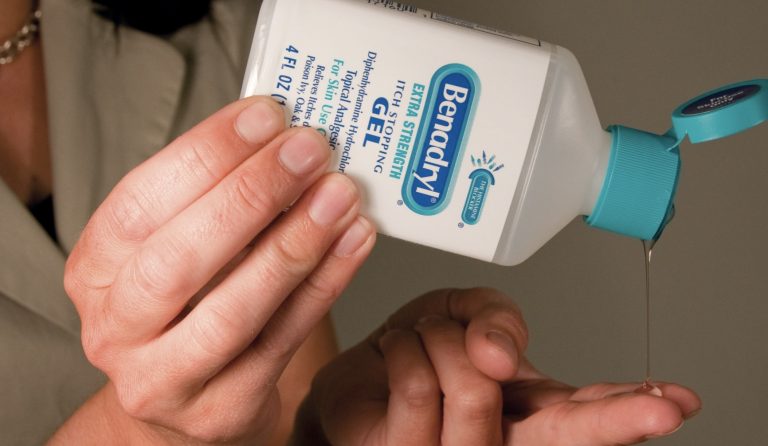Benadryl (a brand name for Diphenhydramine) is a widely-used antihistamine. This medication is used to treat allergy symptoms, such as sneezing, runny nose, itching, rash, and hives. You can buy it at a grocery store, drug store, or pharmacy without a medical prescription.
Sometimes, Benadryl is used as an off-label treatment for colds, flu, insomnia, morning sickness, anxiety, and other health issues. But note that it is essential to consult your doctor before taking diphenhydramine products for any off-label purposes. And in general, before deciding to take any medication, it helps to get all the information you need in order to make an informed choice.
Before purchasing Diphenhydramine-based products, you may want to know how long does benadryl stay in your system, what its half-life period is, whether it indicates on drug tests, and other nuances.
Story Stages
How Fast Does Benadryl Start Working?
When administrated orally (in the form of a pill, a liquid-filled capsule, or a chewable tablet), it will take about 30 minutes for you to begin feeling the effects. And they will reach their peak in about 2 hours. Your food intake won’t interfere with the absorption of Benadryl or decrease its effectiveness.
Diphenhydramine is available in a topical cream, gel, and spray that are used to treat skin allergies. After topical administration, the results will appear within the day. If you get a Benadryl injection, the medicine will start to act right away.
What Is the Half-life of Benadryl?
A medication’s half-life refers simply to the time it takes for 50% of a given dose to be processed and removed from the system. Diphenhydramine has a terminal half-life that ranges from 2.4 to 9.3 hours. For a healthy young adult, the half-life can average out to about 4.3 hours.
Based on these medium figures, it can be calculated that the drug leaves the body in 13.2-49 hours. By the way, the concentration of Diphenhydramine is at its peak between 2 to 4 hours.
What Factors Influence the Period that Diphenhydramine Stays in the System?
Diphenhydramine remains in your system for up to 2 days. Bu the duration of stay may vary due to the factors listed below.
- Dosage
When consumed in high doses, Benadryl detoxification requires more time and effort. Let’s look at the example. The drug’s elimination half-life is 8.5 hours. If someone takes the 100 mg dose, 50 mg will be still present in their system after 8.5 hours. And if someone takes 25 mg, 12.5 mg will stay in their body after 8.5 hours.
Note that taking Benadryl for a longer time or in doses that exceed the recommended daily amount can develop a tolerance, raise the risk of abuse, and even cause addiction with time.
- Frequency of intake
It’s quite clear that if a person gets one dose of the medication per day, the body is likely to eliminate it faster. But since the effects of one dose start to fade within 2-4 hours, this medication is suggested to be administrated multiple times a day. And it obviously takes more time to eliminate a higher amount of accumulated Benadryl.
- Age
Clearance rates for diphenhydramine also differ greatly with age. Research points out that children and young adults can get rid of Benadryl quicker than elderly people aged 65 and older. The time for complete detoxification of the drug residues is 3.1 days in older consumers, 2.1 days in young adults, and 1.2 in kids.
- Interactions with other substances (including alcohol)
Do not mix Diphenhydramine-based medicine with alcohol. This boosts the risks of side effects.
Tranquilizers, sleep aids, antidepressants, and anxiety medicine can increase the drowsiness commonly associated with Benadryl. Tranquilizers can also increase the probability of developing nausea while using the drug.
Do not take other antihistamines while you are on Benadryl to avoid an overdose.
To avoid potential risks, tell your doctor about all other medications and supplements you use.
- General & metabolic health
The liver and kidney are the two major drug elimination organs in the body. People with kidney or liver issues may have a tough time metabolizing Benadryl. It can take a longer period or cause some undesired consequences.
Also, the duration of elimination depends on your metabolism. A faster metabolism means faster expulsion of Benadryl.
Can Drug Tests Detect Benadryl?
Most standard drug tests don’t generally include Diphenhydramine. A specific test is administrated when someone is suspected of abusing it.
The length of time Benadryl’s active component can be detected in the body depends on two factors:
1. The time you took the drug the last time. It can be detectable for 2-4 days after use.
2. The method of drug testing. Three common drug tests used for Diphenhydramine are blood, saliva, and urine tests. Blood tests can detect Diphenhydramine for up to 1-2 days after the last dosage, saliva tests – for 3-4 days, and urine tests – for around 4 days.
However, Diphenhydramine can show false-positive results more often than other types of antihistamines.
Benadryl Detox or How to Clean the Body from Benadryl Safely
Diphenhydramine remains in the system for up to 2 days. If necessary, you can try to accelerate the removal with the help of the following methods:
Hydrate
Drinking more water can help as it fastens the functioning of your kidney which is responsible for Benadryl elimination.
Take low doses (or skip it)
As simple as it can be, the smaller the dose is, the faster your liver and kidney metabolize and remove it from the system.
Be physically active
Physical activities can elevate your metabolic rate. Even simple household chores like washing the dishes or cleaning the room can make a difference.
Seek Emergency Care
If you happen to overdose, seek medical attention immediately.
And in conclusion, let us remind you to read your prescription label or product information label before taking this anti-allergy drug.
